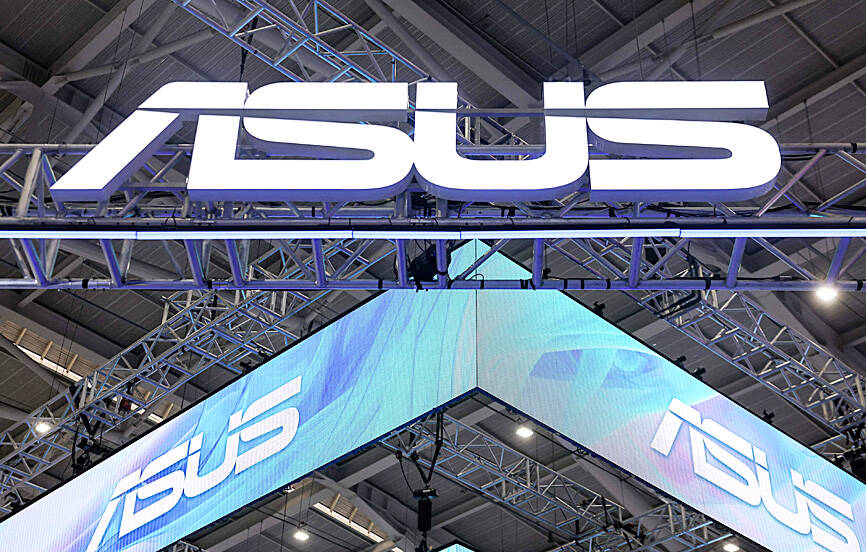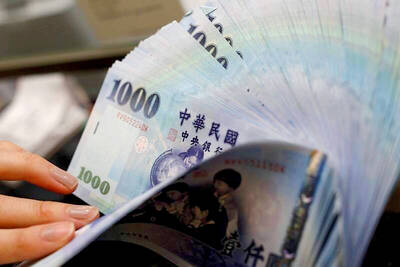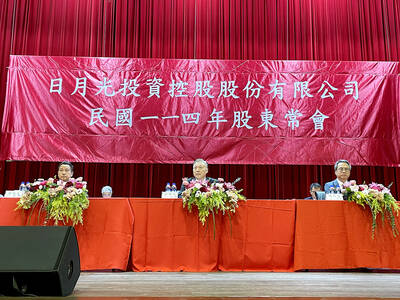PC vendor Asustek Computer Inc (華碩) yesterday posted its strongest profit in 10 quarters for the second quarter, thanks to robust sales of PCs and servers, as well as greater royalty income.
Net profit soared 117 percent quarter-on-quarter and 356 percent year-on-year to NT$11.8 billion (US$361 million) during the quarter ending June 30, compared with NT$5.45 billion in the first quarter and NT$2.59 billion in the second quarter last year.
Earnings per share jumped to NT$15.9 from NT$7.3 the previous quarter and NT$3.5 a year earlier.

Photo: Cheng I-hwa, AFP
Nonoperating profit last quarter totaled NT$4 billion, including NT$1 billion of royalty income from licensing its 3G, 4G and 5G communications intellectual property (IP), Asustek said.
“We are seeing high demand for those communications technologies used in a variety of devices, including next-generation vehicles. We are expecting a growing number of devices and companies using those IP in the future,” Asustek cochief executive officer S.Y. Hsu (許先越) told an online investors’ conference yesterday.
“Thus we are optimistic about increases in royalty income over the next few years. We are expecting royalty income to reach NT$1 billion every year,” Hsu said.
By product, servers outshone all other segments last quarter, Asustek cochief executive officer Samson Hu (胡書賓) said.
The server business contributed 10 to 15 percent of the company’s total revenue last quarter, versus less than 10 percent in the first quarter, Hu said.
Asustek expects server revenue to increase fivefold this year from 2022, rather than in 2027 as it forecast previously.
Asustek also expects PC shipments to expand between 15 percent and 20 percent quarter-on-quarter this quarter, fueled by demand for artificial intelligence (AI) PCs. PCs contributed 56 percent of the company’s revenue last quarter.
The company aims to seize 25 percent of the world’s AI PC market, up from 20 percent, it said.
Shipments of components and servers are to increase between 5 percent and 10 percent quarter-on-quarter this quarter, Asustek said.
Most servers shipped later this year would be mostly equipped with Nvidia Corp’s H100 and H200 graphics processing units (GPUs), the company said.
Asustek declined to comment on reports that Nvidia’s new Blackwell GPU solutions would be delayed due to design flaws. The PC vendor said it would match its partner’s pace in rolling out new servers outfitted with the latest GPU solutions. Servers powered by new GPU solutions are in the process of being certified by customers, it said.
Asustek is seeking to hit the high end of its operating margin target of between 4 percent and 5 percent this year, chief financial officer Nick Wu (吳長榮) said.
The company’s operating margin climbed to 7.8 percent last quarter, from 4.1 percent in the first quarter and 1.1 percent in the same period last year.

Merida Industry Co (美利達) has seen signs of recovery in the US and European markets this year, as customers are gradually depleting their inventories, the bicycle maker told shareholders yesterday. Given robust growth in new orders at its Taiwanese factory, coupled with its subsidiaries’ improving performance, Merida said it remains confident about the bicycle market’s prospects and expects steady growth in its core business this year. CAUTION ON CHINA However, the company must handle the Chinese market with great caution, as sales of road bikes there have declined significantly, affecting its revenue and profitability, Merida said in a statement, adding that it would

RISING: Strong exports, and life insurance companies’ efforts to manage currency risks indicates the NT dollar would eventually pass the 29 level, an expert said The New Taiwan dollar yesterday rallied to its strongest in three years amid inflows to the nation’s stock market and broad-based weakness in the US dollar. Exporter sales of the US currency and a repatriation of funds from local asset managers also played a role, said two traders, who asked not to be identified as they were not authorized to speak publicly. State-owned banks were seen buying the greenback yesterday, but only at a moderate scale, the traders said. The local currency gained 0.77 percent, outperforming almost all of its Asian peers, to close at NT$29.165 per US dollar in Taipei trading yesterday. The

RECORD LOW: Global firms’ increased inventories, tariff disputes not yet impacting Taiwan and new graduates not yet entering the market contributed to the decrease Taiwan’s unemployment rate last month dropped to 3.3 percent, the lowest for the month in 25 years, as strong exports and resilient domestic demand boosted hiring across various sectors, the Directorate-General of Budget, Accounting and Statistics (DGBAS) said yesterday. After seasonal adjustments, the jobless rate eased to 3.34 percent, the best performance in 24 years, suggesting a stable labor market, although a mild increase is expected with the graduation season from this month through August, the statistics agency said. “Potential shocks from tariff disputes between the US and China have yet to affect Taiwan’s job market,” Census Department Deputy Director Tan Wen-ling

UNCERTAINTIES: The world’s biggest chip packager and tester is closely monitoring the US’ tariff policy before making any capacity adjustments, a company official said ASE Technology Holding Inc (日月光投控), the world’s biggest chip packager and tester, yesterday said it is cautiously evaluating new advanced packaging capacity expansion in the US in response to customers’ requests amid uncertainties about the US’ tariff policy. Compared with its semiconductor peers, ASE has been relatively prudent about building new capacity in the US. However, the company is adjusting its global manufacturing footprint expansion after US President Donald Trump announced “reciprocal” tariffs in April, and new import duties targeting semiconductors and other items that are vital to national security. ASE subsidiary Siliconware Precision Industries Co (SPIL, 矽品精密) is participating in Nvidia